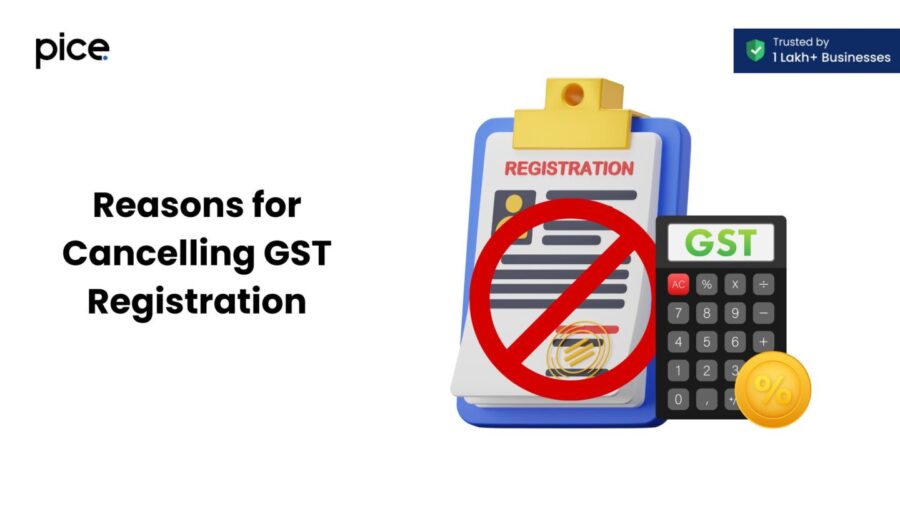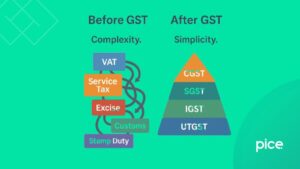Reasons for Cancelling GST Registration
- 29 Aug 24
- 13 mins

Reasons for Cancelling GST Registration
Key Takeaways
- GST registration cancellation can occur due to business closure, transfer of ownership, non-compliance, or falling below the threshold limit.
- Taxpayers can voluntarily cancel their GST registration through the GST portal by submitting an application with required details and supporting documents.
- The GST cancellation procedure by tax authorities involves issuing a show-cause notice and verifying the taxpayer's response before issuing a cancellation order.
- Required documents for GST registration cancellation include proof of business closure, transfer documents, final GST returns, and details of stock inputs.
- Taxpayers can apply for revocation of a canceled GST registration within 30 days of the cancellation order by submitting an application for revocation on the GST portal.
Understanding GST Registration Cancellation
Cancellation of GST registration refers to the process where a registered taxpayer's GSTIN (Goods and Services Tax Identification Number) is invalidated, and they are no longer liable to file GST returns or pay GST. This can occur for various reasons, including business closure, transfer of business ownership, or even voluntary cancellation. A proper understanding of GST registration cancellation is essential for ensuring compliance with GST laws and avoiding any legal repercussions.
When a registered person opts for cancellation, they need to submit an application for cancellation to the tax authorities. The GST portal facilitates this process by providing a unified platform where taxpayers can file their cancellation request. The proper officer then reviews the application and initiates the cancellation proceedings. During this period, the taxpayer must continue filing GST returns until the cancellation is officially processed.
GST registration cancellation is not only limited to voluntary requests. The tax authorities can also initiate cancellation if they identify discrepancies or non-compliance during audits. In such cases, the taxpayer receives a show-cause notice, providing them with an opportunity to address the issues before the final cancellation order is issued. Understanding the intricacies of GST registration cancellation helps taxpayers navigate the process smoothly and ensures they meet all legal requirements.
Who is Eligible to Cancel GST Registration?
Any registered person or entity under the GST regime can apply for cancellation of their GST registration. This includes individuals, partnerships, companies, LLPs, and other business entities. There are specific conditions under which a taxpayer becomes eligible for cancellation. One primary condition is the closure of business operations. If a business owner decides to discontinue their business activities, they can apply for cancellation.
Another scenario is the transfer of business ownership. In cases where a business is sold or transferred to another entity, the original GST registration needs to be canceled, and a new registration must be obtained by the new owner. Additionally, businesses that fall below the threshold limit for GST registration can opt for cancellation. This typically happens when the annual turnover drops below the prescribed limit, making the entity no longer liable to pay GST.
💡If you want to pay your GST with Credit Card, then download Pice Business Payment App. Pice is the one stop app for all paying all your business expenses.
Non-resident taxable persons who no longer engage in taxable supplies within India can also cancel their GST registration. Voluntary registrations, where businesses registered under GST without the mandatory requirement, can also be canceled if the business owner decides to opt-out. The legal heir of a deceased registered taxpayer can apply for the cancellation of GST registration to close the GSTIN of the deceased person. Understanding these eligibility criteria helps taxpayers determine their qualification for GST registration cancellation.
Steps for Cancelling GST Registration

The steps for canceling GST registration involve a series of actions that need to be completed accurately to ensure the process is smooth and legally compliant. Here are the detailed steps:
- Login to GST Portal: The first step is to log in to the GST portal using your credentials. This unified portal is the gateway to manage all GST-related activities.
- Navigate to Cancellation Application: Go to the services tab, then under the registration category, select the option 'Application for Cancellation of Registration'.
- Filling the Application: The taxpayer needs to fill in the details such as the reason for cancellation, the date from which the cancellation is sought, and other required information. Ensure all mandatory fields are completed accurately.
- Upload Necessary Documents: Documents supporting the cancellation request need to be uploaded. This could include proof of business closure, transfer documents, etc.
- Submit the Application: Once the form is filled and documents are uploaded, submit the application. A confirmation message along with an ARN (Application Reference Number) will be generated.
- Verification by Tax Officer: The proper officer will review the application and may issue a show-cause notice if there are any discrepancies or additional information required.
- Response to Show-Cause Notice: If a show-cause notice is issued, the taxpayer must respond within the specified time limit, providing the necessary clarifications or documents.
- Final Cancellation Order: Once the application is verified and found satisfactory, the tax officer will issue the cancellation order, and the GST registration will be officially canceled.
Following these steps ensures that the process of cancellation is thorough and compliant with GST regulations.
GST Cancellation Procedure by Tax Authorities
The GST cancellation procedure initiated by tax authorities typically begins with identifying discrepancies or non-compliance by the registered taxpayer. The tax officer may conduct audits or inspections and if issues are found, they can initiate the cancellation process. The tax authority will issue a show-cause notice to the taxpayer, outlining the reasons for proposed cancellation. This notice provides the taxpayer with an opportunity to respond and rectify the issues if possible.
The taxpayer must respond to the show-cause notice within the stipulated time, usually 30 days. The response should address the concerns raised by the tax authority and provide supporting documentation to resolve any discrepancies. If the tax officer is satisfied with the response, the cancellation proceedings may be halted, and the taxpayer can continue their registration. However, if the response is unsatisfactory or if no response is received, the tax officer will proceed with the cancellation.
The final step involves the issuance of a cancellation order by the tax officer. This order officially terminates the GST registration, and the taxpayer is notified. The taxpayer must then file all pending GST returns up to the date of cancellation and settle any outstanding tax liabilities. The electronic credit ledger is also adjusted to account for any remaining input tax credit. This thorough procedure ensures that cancellations are justified and compliant with GST laws.
Voluntary GST Cancellation Process by the Taxpayer
The voluntary GST cancellation process by the taxpayer is relatively straightforward and can be initiated directly through the GST portal. Here’s a step-by-step guide:
- Initiate the Process: The registered person must log in to the GST portal and select the 'Application for Cancellation of Registration' option under the registration tab.
- Fill in Details: Provide details such as the reason for cancellation (e.g., business closure, transfer of business, opting out of voluntary registration), date from which cancellation is required, and any other pertinent information.
- Submit Application: After filling in the required details, submit the application. A confirmation message along with an ARN (Application Reference Number) will be generated.
- Review and Verification: The application is then forwarded to the proper officer for review. The tax officer may request additional information or documentation if necessary.
- Approval: Upon satisfactory verification, the tax officer will approve the application and issue a formal cancellation order.
- Compliance Post-Cancellation: The taxpayer must ensure that all GST returns are filed up to the date of cancellation, and any outstanding liabilities are cleared. They must also update their vendor management systems to reflect the change in GST status.
This process ensures that voluntary cancellations are handled efficiently, reducing the administrative burden on both the taxpayer and the tax authorities.
Reasons for Cancelling GSTIN
Several reasons can necessitate the cancellation of a GSTIN. One of the primary reasons is the closure of business operations. When a business ceases its activities, there is no need to maintain an active GST registration. Another common reason is the transfer of business ownership. In such cases, the new owner must apply for a fresh GST registration while the previous owner cancels their existing registration.
Businesses may also opt for cancellation if they no longer meet the threshold limit for mandatory GST registration. This can happen when the annual turnover falls below the prescribed limit, making the entity exempt from GST requirements. Non-compliance and fraudulent activities can also lead to cancellation. If a taxpayer is found to be involved in fraudulent activities or fails to comply with GST regulations, the tax authorities can initiate cancellation proceedings.
Additionally, non-resident taxable persons who no longer supply taxable goods or services in India may apply for cancellation. Voluntary registrations can be canceled if the taxpayer decides they no longer wish to be under the GST regime. Understanding these reasons helps taxpayers identify when they need to apply for GST registration cancellation.
Required Information for GST Registration Cancellation

When applying for GST registration cancellation, specific information must be provided to ensure the application is processed smoothly. This includes the GSTIN of the registered taxpayer, the legal name of the business, and the address of the principal place of business. The applicant must also provide the reason for cancellation, such as business closure, transfer of ownership, or opting out of voluntary registration.
The date from which cancellation is sought must be specified, and any supporting documents should be uploaded. For instance, if the reason for cancellation is the transfer of business, relevant transfer documents should be provided. If the cancellation is due to business closure, proof of discontinuation, such as a closure declaration, must be attached.
Additionally, details of the stock inputs and any input tax credit claimed must be provided. The taxpayer must ensure all pending GST returns are filed, and any outstanding tax liabilities are cleared. Accurate and complete information is crucial for the proper officer to process the cancellation request without delays.
Impact of Cancelling GST Registration
Cancelling GST registration has significant implications for a business. Firstly, the business will no longer be required to file GST returns or pay GST. This can reduce administrative and financial burdens, especially for small businesses that fall below the threshold limit. However, it also means the business cannot charge GST on its supplies or claim input tax credits, which could impact pricing and profitability.
The cancellation also affects business compliances. The business must file a final return, known as GSTR-10, within three months of cancellation, detailing the stock held on the date of cancellation and paying any outstanding tax liability. Failure to comply can result in penalties and legal issues.
Moreover, once the GST registration is canceled, the business must update all its records and inform its vendors and customers. This is crucial to avoid confusion and ensure smooth business operations. The business must also cease issuing tax invoices and must remove any mention of GST from its receipts and promotional materials.
Revoking GST Cancellation
In certain situations, a taxpayer may need to revoke a previously canceled GST registration. The process for revocation involves submitting an application for revocation within 30 days of the cancellation order. The taxpayer must log in to the GST portal and navigate to the 'Application for Revocation of Cancellation' option.
The application should include the reasons for revocation and any supporting documents. The tax officer reviews the application and may request additional information if needed. If the application is found satisfactory, the tax officer will issue an order for revocation, reinstating the GST registration.
Revocation of cancellation is essential for businesses that wish to resume operations or have rectified the issues that led to the cancellation. It ensures continuity in business operations and compliance with GST laws. Therefore, understanding the revocation procedure and timely action is crucial for maintaining a valid GST registration.
FAQs
What is the reason for GST cancellation?
How do I clarify for GST cancellation?
What are the reasons for GST rejection?
How do I write a letter to cancel GST?
1. Your business name, address, and GSTIN.
2. A subject line stating the purpose, e.g., "Application for Cancellation of GST Registration".
3. The reason for cancellation (e.g., closure of business, transfer of ownership).
4. The date from which the cancellation is sought.
5. Any supporting documents.
6. A polite request for processing the cancellation.
 By
By 















